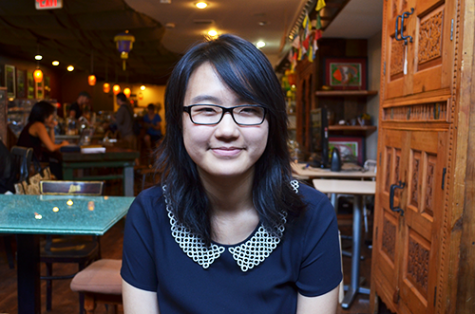Prominent comic artist Chris Ware speaks the Cleveland Public Library
Offers rare look inside his inspiration, works, and process
October 11, 2013
Prominent comic artist Chris Ware went to the Cleveland Public Library on Saturday Oct. 5, as part of the annual “Writers and Readers” series at the library. Ware began his talk, humorously saying, “Thanks for coming out and ruining a perfect Saturday” and apologizing for having the audience listen to his “annoying nasal monotone.”
Ware’s humor continued throughout the series, adding a touch of lightness to his otherwise somber topics, including his art.
His comics tend to explore human emotions, such as loneliness and how humans interact with each other, which have been praised for how it “completely redefined and expanded the inherent potential of comics” by fellow cartoonist Ivan Burnetti.
Although Ware describes his own work using self-effacing and modest terms, his work is original and detailed, oftentimes portraying complicated emotions with simple lines.
Ware grew up in a newspaper family and attended art classes at the urging of his mother. While at art school, he was exposed to Renaissance art. The work of both Leonardo da Vinci and Michelangelo inspired him, making him want to emulate them. Their attention to detail is both evident in Ware’s non-comic life drawings that he created while at art school as well as his comics. His use of stark lines that give strength and the detail used in the face was evident early on.
From Ware’s slides showing his journey from art school to his present day job as a cartoonist, his transition between mediums (and ultimately his call to comics) is obvious. Ware started out as a painter, then became a sculptor, but he was unhappy with his art. He couldn’t find “emotional truth” in his art. Slowly, he started using metaphors to mean something and soon that branched into comic drawing.
Although Ware found his calling in cartooning, he’s still experimenting with the layout, colors, drawing, display and more. He showed the process of how he designs books and it’s still as meticulous as his other works. Ware thinks about it as a sculpture, all the pieces coming together to have one big meaning.
Most of Ware’s work explores humans, scrutinizing our species to the point of uncomfortableness and it’s oftentimes satirical. In his work, “Acme Novelty Library,” Ware tries to show how adults oftentimes distort reality and how that affects the way the world is viewed. Similarly, in “Quimby the Mouse,” Ware explores how human relationships tend to become conflict-ridden even in love, through Quimby, a mouse, and Sparky, a cathead.
Showing his plan for a comic that he made for Wired Magazine’s first iPad edition, Ware amazed the audience with how interactive the strip was. It allowed the reader to interact with the panels, having the reader tap, scroll and more to reveal more of the story. While the idea didn’t turn into fruition because of how complicated it was, Ware’s attention to detail and his consideration with how the reader interacts with the comic are notable.
Ware also revealed his influences, which included Gustave Flabert, Marcel Proust and James Joyce as well as his artist influences, such as Art Spiegelman, Hokusai and Kim Dietch.
The Q&A that followed the talk excited the audience as Ware fielded questions ranging from whether or not he read a particular comic to how he deals with artist’s block. Ware revealed that up until very recently, he didn’t like his own work and would often tear up his work in frustration. It was very difficult for him to draw and be satisfied with his work, despite his love for comics. Ware also revealed that the rarity of names in his work is due to the fact that names are defining and he doesn’t want that.
Although Chris Ware once said, “I guess I just don’t like being physically in front of people I don’t know very well, because I expect to be ‘seen through,’ or, even worse, instantly hated,” the audience at the Cleveland Public Library loved him.


